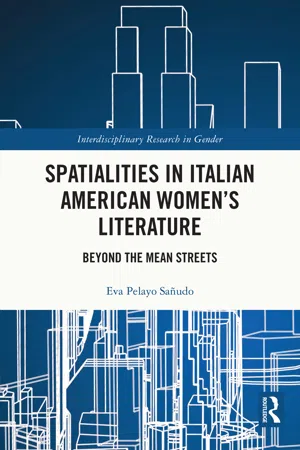
Spatialities in Italian American Women's Literature
Beyond the Mean Streets
- 200 pages
- English
- ePUB (mobile friendly)
- Available on iOS & Android
About This Book
Examining the family saga as an instrument of literary analysis of writing by Italian American women, this book argues that the genre represents a key strategy for Italian American female writers as a form which distinctly allows them to establish cultural, gender and literary traditions.
Spaces are inherently marked by the ideology of the societies that create and practice them, and this volume engages with spaces of cultural and gendered identity, particularly those of the 'mean streets' in Italian American fiction, which provide a method of critically analyzing the configurations and representations of identity associated with the Italian American community. Key authors examined include Julia Savarese, Marion Benasutti, Tina De Rosa, Helen Barolini, Melania Mazzucco and Laurie Fabiano.
This book is suitable for students and scholars in Literature, Italian Studies, Cultural Studies and Gender Studies.
Frequently asked questions
Information
1 Icons of ethnicity
Identity and representation of Italian Americans
Controlling images and mean streets: the cultural space of Italian American Women
They describe us. […] That’s all. They have the power of description, and we succumb to the pictures they construct.—Salman Rushdie, The Satanic Verses
There is also a subcategory of wiseguys films that propose comic parodies of works depicting serious Italian American criminals. Hollywood Italians thus appear in thematic clusters of films that are both Hollywood generic films and specific illustrations of Italian American versions of such traditional genres.(2010, 217)
most audiences reacted to The Sopranos as more than just another continuation of the gangster stereotype (although this aspect is certainly present); they enthusiastically followed the lives of a group of Italian Americans who were so completely assimilated that they became universal representations of us all, even if some of their activities took place outside the law.(2010, 221)
Table of contents
- Cover
- Half Title
- Series Page
- Title Page
- Copyright Page
- Table of Contents
- Acknowledgments
- Chapter 1: Icons of ethnicity: Identity and representation of Italian Americans
- Chapter 2: The Italian American counter-flâneuse: The right to the city and embodied streets in Julia Savarese’s The Weak and the Strong (1952) and Marion Benasutti’s No Steady Job for Papa (1966)
- Chapter 3: Genealogies of place: Spatial belonging in Helen Barolini’s Umbertina (1979) and Tina De Rosa’s Paper Fish (1980)
- Chapter 4: Gendering the urban pioneers: Pictorial and emotional geographies in Melania Mazzucco’s Vita (2003) and Laurie Fabiano’s Elizabeth Street (2006)
- Index